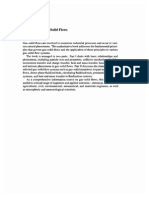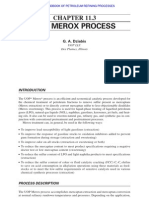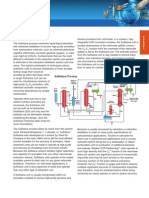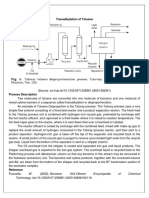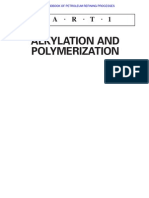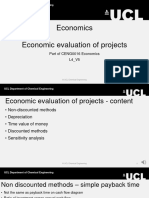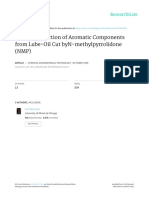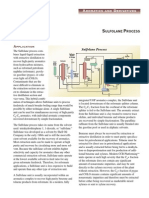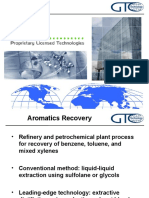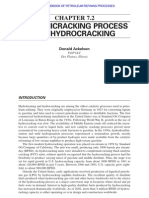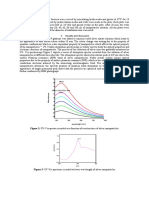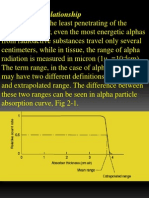Uop Sulfolane Process: Thomas J. Stoodt and Antoine Negiz
Uop Sulfolane Process: Thomas J. Stoodt and Antoine Negiz
Uploaded by
Bharavi K SCopyright:
Available Formats
Uop Sulfolane Process: Thomas J. Stoodt and Antoine Negiz
Uop Sulfolane Process: Thomas J. Stoodt and Antoine Negiz
Uploaded by
Bharavi K SOriginal Title
Copyright
Available Formats
Share this document
Did you find this document useful?
Is this content inappropriate?
Copyright:
Available Formats
Uop Sulfolane Process: Thomas J. Stoodt and Antoine Negiz
Uop Sulfolane Process: Thomas J. Stoodt and Antoine Negiz
Uploaded by
Bharavi K SCopyright:
Available Formats
Source: HANDBOOK OF PETROLEUM REFINING PROCESSES
CHAPTER 2.2
UOP SULFOLANE PROCESS
Thomas J. Stoodt and Antoine Negiz
Marketing Services UOP LLC Des Plaines, Illinois
INTRODUCTION
The UOP Sulfolane* process is used to recover high-purity aromatics from hydrocarbon mixtures, such as reformed petroleum naphtha (reformate), pyrolysis gasoline (pygas), or coke-oven light oil. The Sulfolane process takes its name from the solvent used: tetrahydrothiophene 1,1dioxide, or Sulfolane. Sulfolane was developed as a solvent by Shell in the early 1960s and is still the most efficient solvent available for the recovery of aromatics. Since 1965, UOP has been the exclusive licensing agent for the Sulfolane process. Many of the process improvements incorporated in a modern Sulfolane unit are based on design features and operating techniques developed by UOP. The Sulfolane process can be applied as a combination of liquid-liquid extraction (LLE) and extractive distillation (ED) or, with an appropriate feed, ED alone. The choice is a function of the feedstock and the processing objectives, as explained below. The Sulfolane process is usually incorporated in an aromatics complex to recover highpurity benzene and toluene products from reformate. In a modern, fully integrated UOP aromatics complex (Fig. 2.2.1), the Sulfolane unit is located downstream of the reformate splitter column. The C6-C7 fraction from the overhead of the reformate splitter is fed to the Sulfolane unit. The aromatic extract from the Sulfolane unit is clay-treated to remove trace olefins, and individual benzene and toluene products are recovered by simple fractionation. The paraffinic raffinate from the Sulfolane unit is usually blended into the gasoline pool or used in aliphatic solvents. A complete description of the entire aromatics complex may be found in Chap. 2.1. The Sulfolane process can also be an attractive way to reduce the benzene concentration in a refinerys gasoline pool so that it meets new reformulated gasoline requirements. In a typical benzene-reduction application (Fig. 2.2.2), a portion of the debutanized reformate is sent to a reformate splitter column. The amount of reformate sent to the splitter is determined by the degree of benzene reduction required. Bypassing some reformate around the splitter and recombining it with splitter bottoms provide control of the final benzene concentration. The benzene-rich splitter overhead is sent to the Sulfolane unit,
*Trademark and/or service mark of UOP.
2.13 Downloaded from Digital Engineering Library @ McGraw-Hill (www.digitalengineeringlibrary.com) Copyright 2004 The McGraw-Hill Companies. All rights reserved. Any use is subject to the Terms of Use as given at the website.
UOP SULFOLANE PROCESS 2.14
BASE AROMATICS PRODUCTION PROCESSES
FIGURE 2.2.1 Integrated UOP aromatics complex.
FIGURE 2.2.2 Benzene-reduction application.
which produces a high-purity benzene product that can be sold to the petrochemical market. The raffinate from the Sulfolane unit can be blended back into the gasoline pool or upgraded in an isomerization unit. Improvements in the Sulfolane process have allowed the application of extractive distillation alone to feeds that have traditionally been sent to a combination LLE/ED unit. For the same feed rate, an extractive distillation unit is about 80 percent of the installed cost of a combined LLE/ED unit. The economics of one versus the other is largely a question of the utilities required to achieve the high-purity product specifications at satisfactory recoveries of BTX. The application of extractive distillation is favored when the Sulfolane feed is rich in aromatics. In such a case, there is less raffinate to boil overhead in the extractive distillation column, which consumes energy.
Downloaded from Digital Engineering Library @ McGraw-Hill (www.digitalengineeringlibrary.com) Copyright 2004 The McGraw-Hill Companies. All rights reserved. Any use is subject to the Terms of Use as given at the website.
UOP SULFOLANE PROCESS
UOP SULFOLANE PROCESS
2.15
The more economical choice is an economic and engineering decision. Factors to consider include:
New versus revamp equipment Cost of utilities Feed composition (boiling range, nonaromatics, impurities) Product specifications
SOLVENT SELECTION
The suitability of a solvent for aromatics extraction involves the relationship between the capacity of the solvent to absorb aromatics (solubility) and the ability of the solvent to differentiate between aromatics and nonaromatics (selectivity). A study of the common polar solvents used for aromatic extraction reveals the following qualitative similarities:
When hydrocarbons containing the same number of carbon atoms are compared, solubilities decrease in this order: aromatics naphthenes olefins paraffins. When hydrocarbons in the same homologous series are compared, solubility decreases as molecular weight increases. The selectivity of a solvent decreases as the hydrocarbon content, or loading, of the solvent phase increases.
In spite of these general similarities, various commercial solvents used for aromatics recovery have significant quantitative differences. Sulfolane demonstrates better aromatic solubilities at a given selectivity than any other commercial solvent. The practical consequence of these differences is that an extraction unit designed to use Sulfolane solvent requires a lower solvent circulation rate and thus consumes less energy. In addition to superior solubility and selectivity, Sulfolane solvent has three particularly advantageous physical properties that have a significant impact on plant investment and operating cost:
High specific gravity (1.26). High specific gravity allows the aromatic capacity of Sulfolane to be fully exploited while maintaining a large density difference between the hydrocarbon and solvent phases in the extractor. This large difference in densities minimizes the required extractor diameter. The high density of the liquid phase in the extractive distillation section also minimizes the size of the equipment required there. Low specific heat0.4 cal/(g C) [0.4 Btu/(lb F)]. The low specific heat of Sulfolane solvent reduces heat loads in the fractionators and minimizes the duty on solvent heat exchangers. High boiling point [287C (549F)]. The boiling point of Sulfolane is significantly higher than that of the heaviest aromatic hydrocarbon to be recovered, facilitating the separation of solvent from the aromatic extract.
PROCESS CONCEPT
The Sulfolane process combines both liquid-liquid extraction and extractive distillation in the same process unit. This mode of operation has particular advantages for aromatic recovery:
Downloaded from Digital Engineering Library @ McGraw-Hill (www.digitalengineeringlibrary.com) Copyright 2004 The McGraw-Hill Companies. All rights reserved. Any use is subject to the Terms of Use as given at the website.
UOP SULFOLANE PROCESS 2.16
BASE AROMATICS PRODUCTION PROCESSES
In liquid-liquid extraction systems, light nonaromatic components are more soluble in the solvent than heavy nonaromatics are. Thus, liquid-liquid extraction is more effective in separating aromatics from the heavy contaminants than from the light ones. In extractive distillation, light nonaromatic components are more readily stripped from the solvent than heavy nonaromatics. Thus, extractive distillation is more effective in separating aromatics from the light contaminants than from the heavy ones.
Therefore, liquid-liquid extraction and extractive distillation provide complementary features. Contaminants that are the most difficult to eliminate in one section are the easiest to remove in the other. This combination of techniques permits effective treatment of feedstocks with much broader boiling range than would be possible by either technique alone. The basic process concept is illustrated in Fig. 2.2.3. Lean solvent is introduced at the top of the main extractor and flows downward. The hydrocarbon feed is introduced at the bottom and flows upward, countercurrent to the solvent phase. As the solvent phase flows downward, it is broken up into fine droplets and redispersed into the hydrocarbon phase by each successive tray. The solvent selectively absorbs the aromatic components from the feed. However, because the separation is not ideal, some of the nonaromatic impurities are also absorbed. The bulk of the nonaromatic hydrocarbons remain in the hydrocarbon phase and are rejected from the main extractor as raffinate. The solvent phase, which is rich in aromatics, flows downward from the main extractor into the backwash extractor. There the solvent phase is contacted with a stream of light nonaromatic hydrocarbons from the top of the extractive stripper. The light nonaromatics displace the heavy nonaromatic impurities from the solvent phase. The heavy nonaromatics then reenter the hydrocarbon phase and leave the extractor with the raffinate. The rich solvent from the bottom of the backwash extractor, containing only light nonaromatic impurities, is then sent to the extractive stripper for final purification of the aromatic product. The light nonaromatic impurities are removed overhead in the extractive stripper and recycled to the backwash extractor. A purified stream of aromatics, or extract, is withdrawn in the solvent phase from the bottom of the extractive stripper. The solvent phase is then sent on to the solvent recovery column, where the extract product is separated from the solvent by distillation. Also shown in Fig. 2.2.3 are the activity coefficients, or K values, for each section of the separation. The K value in extraction is analogous to relative volatility in distillation. The Ki value is a measure of the solvents ability to repel component i and is defined as the mole fraction of component i in the hydrocarbon phase Xi, divided by the mole fraction of component i in the solvent phase Zi. The lower the value of Ki, the higher the solubility of component i in the solvent phase.
DESCRIPTION OF THE PROCESS FLOW
Fresh feed enters the extractor and flows upward, countercurrent to a stream of lean solvent, as shown in Fig. 2.2.4. As the feed flows through the extractor, aromatics are selectively dissolved in the solvent. A raffinate stream, very low in aromatics content, is withdrawn from the top of the extractor. The rich solvent, loaded with aromatics, exits the bottom of the extractor and enters the stripper. The nonaromatic components having volatilities higher than that of benzene are completely separated from the solvent by extractive distillation and removed overhead along with a small quantity of aromatics. This overhead stream is recycled to the extractor, where the light nonaromatics displace the heavy nonaromatics from the solvent phase leaving the bottom of the extractor.
Downloaded from Digital Engineering Library @ McGraw-Hill (www.digitalengineeringlibrary.com) Copyright 2004 The McGraw-Hill Companies. All rights reserved. Any use is subject to the Terms of Use as given at the website.
UOP SULFOLANE PROCESS
UOP SULFOLANE PROCESS
2.17
FIGURE 2.2.3 Sulfolane process concept.
The stripper bottoms stream, which is substantially free of nonaromatic impurities, is sent to the recovery column, where the aromatic product is separated from the solvent. Because of the large difference in boiling point between the Sulfolane solvent and the heaviest aromatic component, this separation is accomplished with minimal energy input. To minimize solvent temperatures, the recovery column is operated under vacuum. Lean solvent from the bottom of the recovery column is returned to the extractor. The extract is recovered overhead and sent on to distillation columns downstream for recovery of the individual benzene and toluene products. The raffinate stream exits the top of the extractor and is directed to the raffinate wash column. In the wash column, the raffinate is contacted with water to remove dissolved solvent. The solvent-rich water is vaporized in the water stripper by exchange with hot circulating solvent and then used as stripping steam in the recovery column. Accumulated solvent from the bottom of the water stripper is pumped back to the recovery column. The raffinate product exits the top of the raffinate wash column. The amount of Sulfolane solvent retained in the raffinate is negligible. The raffinate product is commonly used for gasoline blending or aliphatic solvent applications. Under normal operating conditions, Sulfolane solvent undergoes only minor oxidative degradation. A small solvent regenerator is included in the design of the unit as a safeguard
Downloaded from Digital Engineering Library @ McGraw-Hill (www.digitalengineeringlibrary.com) Copyright 2004 The McGraw-Hill Companies. All rights reserved. Any use is subject to the Terms of Use as given at the website.
UOP SULFOLANE PROCESS
2.18 Downloaded from Digital Engineering Library @ McGraw-Hill (www.digitalengineeringlibrary.com) Copyright 2004 The McGraw-Hill Companies. All rights reserved. Any use is subject to the Terms of Use as given at the website.
FIGURE 2.2.4 Sulfolane flow diagram.
UOP SULFOLANE PROCESS
UOP SULFOLANE PROCESS
2.19
against the possibility of air leaking into the unit. During normal operation, a small slipstream of circulating solvent is directed to the solvent regenerator for removal of oxidized solvent. The extract product from a Sulfolane unit may contain trace amounts of olefins and other impurities that would adversely affect the acid-wash color tests of the final benzene and toluene products. To eliminate these trace impurities, the extract is clay-treated prior to fractionation. Because clay treating is done at mild conditions, clay consumption is minimal. The treated extract is directed to the aromatics fractionation section, where high-purity benzene, toluene, and sometimes mixed xylenes are recovered. The design of the aromatics fractionation section varies depending on the particular processing requirements of the refiner. The toluene product is often recycled to a UOP Tatoray* unit for conversion into benzene and xylenes. Mixed xylenes may be routed directly to the xylene recovery section of the plant for separation into para-xylene, ortho-xylene, and meta-xylene products. Any heavy aromatics in the feed are yielded as a bottoms product from the fractionation section. In most cases, the C9 aromatics are recovered and recycled to a UOP Tatoray unit for the production of additional xylenes. The heavy aromatics may also be blended back into the refinery gasoline pool or sold as a high-octane blending component. Figure 2.2.5 shows the process flow of a Sulfolane extractive distillation unit. There are two primary columns in the extractive distillation unit: the extractive distillation column and the solvent recovery column (or solvent stripper column). Aromatic feed is directed to the ED column. It exchanges heat with the lean solvent and enters a central stage of the trayed column. The lean solvent is introduced near to the top of the ED column. Combining solvent and feed alters the relative volatilities of the components to be separated because of the nonideal behavior of the mixture. This is key to the process. The selectivity of the solvent renders aromatics relatively less volatile than the nonaromatics, as shown in the bottom right chart of Fig. 2.2.3. Good product purity can be achieved if there is sufficient separation of K values between the lowest carbon number aromatic and the higher carbon number nonaromatic species.
ED Column
Recovery Column
Steam
Steam
Extract
Raffinate
Solvent Regenerator Water Stripper
Steam
Feed
FIGURE 2.2.5 Shell Sulfolane process: extractive distillation.
*Trademark and/or service mark of UOP.
Downloaded from Digital Engineering Library @ McGraw-Hill (www.digitalengineeringlibrary.com) Copyright 2004 The McGraw-Hill Companies. All rights reserved. Any use is subject to the Terms of Use as given at the website.
UOP SULFOLANE PROCESS 2.20
BASE AROMATICS PRODUCTION PROCESSES
As the hydrocarbon vapor stream flows up the ED column, countercurrent to the descending solvent, the aromatics are selectively absorbed. The function of the upper section of the extractive distillation column is to maximize aromatic recovery. The overhead vapor is nonaromatic and is referred to as the raffinate. These vapors are condensed and sent to storage. A portion of the raffinate liquid is used as column reflux to rectify entrained solvent out of the overhead product. Overhead water is collected in the raffinate receiver water boot and returned to the unit water circuit. The extractive distillation column is reboiled with steam. In the lower section of the ED column, the nonaromatics are preferentially stripped out of the liquid and enter the upper portion of the column as a vapor phase due to the solvent selectivity, which has made the saturates relatively more volatile than the aromatics. Again, because of finite selectivity, some aromatics, primarily benzene, are stripped into the upper section of the column where they must be reabsorbed. The lower section of the ED column serves the function of benzene purification. The ED column bottoms contain solvent and highly purified aromatics. These materials are sent to the solvent recovery column (solvent stripper column). In this column, aromatics are separated by solvent under vacuum with steam stripping. The overhead aromatic product, depending on the composition (B or BT), is condensed and sent to storage or to clay treating prior to product fractionation. A portion of the extract liquid is used as reflux to remove residual solvent from the extract vapors. The solvent recovery column is reboiled with steam. Water is collected in the extract receiver boot and is directed to the water stripper. This small reboiled column (heated by exchange with the solvent stripper bottoms) generates the stripping steam that is returned to the bottom of the solvent recovery column via the solvent regenerator. Solvent, as it flows down the recovery column, is purified of residual hydrocarbons. At the bottom of the recovery column the solvent is essentially pure Sulfolane with a small amount of water. This is then returned to the ED column as lean solvent. A slipstream of lean solvent is directed to a solvent regenerator to remove any degradation products.
FEEDSTOCK CONSIDERATIONS
The feed to a Sulfolane unit is usually a benzene-toluene (BT) cut from a naphtha reforming unit. The xylene fraction of the reformate is often already pure enough to sell as mixed xylenes or is sent directly to the para-xylene recovery section of the aromatics complex. In many facilities, the pygas by-product from a nearby ethylene plant is also directed to a Sulfolane unit. A few plants also use Sulfolane to recover aromatics from coke-oven light oil. Before being sent to a Sulfolane unit, the reformate must first be stripped in a debutanizer column to remove light ends. Pygas and coke-oven light oils must first be hydrotreated to remove dienes, olefins, sulfur, and nitrogen. In general, the feed to a Sulfolane unit should meet the specifications outlined in Table 2.2.1.
PROCESS PERFORMANCE
The performance of the UOP Sulfolane process has been well demonstrated in more than 100 operating units. The recovery of benzene exceeds 99.9 wt %, and recovery of toluene is typically 99.8 wt %. The Sulfolane process is also efficient at recovering heavier aromatics if necessary. Typical recovery of xylenes exceeds 98 wt %, and a recovery of 99 wt % has been demonstrated commercially with rich feedstocks.
Downloaded from Digital Engineering Library @ McGraw-Hill (www.digitalengineeringlibrary.com) Copyright 2004 The McGraw-Hill Companies. All rights reserved. Any use is subject to the Terms of Use as given at the website.
UOP SULFOLANE PROCESS
UOP SULFOLANE PROCESS
2.21
TABLE 2.2.1 Contaminant Total sulfur Thiophene Total chloride Bromine number Diene index
Sulfolane Feedstock Specifications Effect Contaminates product Contaminates product Contaminates product, causes corrosion Causes higher solvent circulation, increased utility consumption Causes higher solvent circulation, increased utility consumption Causes degradation of solvent Limit 0.2 ppm max. 0.2 ppm max. 0.2 ppm max. 2 max. 1 max. 1.0 ppm max.
Dissolved oxygen
UOP Sulfolane units routinely produce a benzene product with a solidification point of 5.5C or better, and many commercial units produce benzene containing less than 100 ppm nonaromatic impurities. The toluene and C8 aromatics products from a Sulfolane unit are also of extremely high purity and easily exceed nitration-grade specifications. In fact, the ultimate purities of all the aromatic products are usually more dependent on the design and proper operation of the downstream fractionation section than on the extraction efficiency of the Sulfolane unit itself. The purity and recovery performance of an aromatics extraction unit is largely a function of energy consumption. In general, higher solvent circulation rates result in better performance, but at the expense of higher energy consumption. The UOP Sulfolane process demonstrates the lowest energy consumption of any commercial aromatics extraction technology. A typical UOP Sulfolane unit consumes 275 to 300 kcal of energy per kilogram of extract produced, even when operating at 99.99 wt % benzene purity and 99.95 wt % recovery. UOP Sulfolane units are also designed to efficiently recover solvent for recycle within the unit. Expected solution losses of Sulfolane solvent are less than 5 ppm of the fresh feed rate to the unit.
EQUIPMENT CONSIDERATIONS
The extractor uses rain-deck trays to contact the upward-flowing feed with the downwardflowing solvent. The rain-deck trays act as distributors to maintain an evenly dispersed rain of solvent droplets moving down through the extractor to facilitate dissolution of the aromatic components into the solvent phase. A typical Sulfolane extractor column contains 94 rain-deck trays. The raffinate wash column is used to recover residual solvent carried over in the raffinate from the extractor. The wash column uses jet-deck trays to provide countercurrent flow between the wash water and raffinate. A typical wash column contains eight jet-deck trays. The stripper column is used to remove any light nonaromatic hydrocarbons in the rich solvent by extractive distillation. The Sulfolane solvent increases the relative volatilities between the aromatic and nonaromatic components, thus facilitating the removal of light nonaromatics in the column overhead. A typical stripper column contains 34 sieve trays. The recovery column separates the aromatic extract from the Sulfolane solvent by vacuum distillation. A typical recovery column contains 34 valve trays. The Sulfolane extractive distillation unit has less equipment than a conventional unit. The rain-deck extractor and raffinate wash column are eliminated. Solvent in the raffinate,
Downloaded from Digital Engineering Library @ McGraw-Hill (www.digitalengineeringlibrary.com) Copyright 2004 The McGraw-Hill Companies. All rights reserved. Any use is subject to the Terms of Use as given at the website.
UOP SULFOLANE PROCESS 2.22
BASE AROMATICS PRODUCTION PROCESSES
as described above, is eliminated by the ED column reflux. In the case of a benzene-only feed, all the equipment associated with water circulation and stripping steam can be eliminated. A Sulfolane unit is approximately 80 percent of the cost of an LLE/ED unit. The solvent regenerator is a short, vertical drum that is used to remove the polymers and salts formed as a result of the degradation of solvent by oxygen. The regenerator is operated under vacuum and runs continuously. The Sulfolane process is highly heat-integrated. Approximately 11 heat exchangers are designed into a typical unit. All the equipment for the Sulfolane unit, with the exception of the solvent regenerator reboiler, is specified as carbon steel. The solvent regenerator reboiler is constructed of stainless steel.
CASE STUDY
A summary of the investment cost and utility consumption for a typical Sulfolane unit is shown in Table 2.2.2. The basis for this case is a Sulfolane unit processing 54.5 metric tons per hour (MT/h) [10,400 barrels per day (BPD)] of a BT reformate cut. This case corresponds to the case study for an integrated UOP aromatics complex in Chap. 2.1 of this handbook. The investment cost is limited to the Sulfolane unit itself and does not include downstream fractionation. The estimated erected cost for the Sulfolane unit assumes construction on a U.S. Gulf Coast site in 2002. The scope of the estimate includes engineering, procurement, erection of equipment on the site, and the initial inventory of Sulfolane solvent.
COMMERCIAL EXPERIENCE
Since the early 1950s, UOP has licensed four different aromatics extraction technologies, including the Udex,* Sulfolane, Tetra,* and Carom* processes. UOPs experience in aromatics extraction encompasses more than 200 units, which range in size from 2 to 260 MT/h (400 to 50,000 BPD) of feedstock. In 1952, UOP introduced the first large-scale aromatics extraction technology, the Udex process, which was jointly developed by UOP and Dow Chemical. Although the Udex process uses either diethylene glycol or triethlyene glycol as a solvent, it is similar to the Sulfolane process in that it combines liquid-liquid extraction with extractive distillation. Between 1950 and 1965, UOP licensed a total of 82 Udex units.
*Trademark and/or service mark of UOP.
TABLE 2.2.2 Investment Cost and Utility Consumption* Estimated erected cost, million $ U.S. Utility consumption: Electric power, kW High-pressure steam, MT/h (klb/h) Cooling water, m3/h (gal/min) 13.5 390 27.5 (60.6) 274 (1207)
*Basis: 25.0 MT/h of toluene product, 11.8 MT/h of benzene product, 54.5 MT/h (10,400 BPD) of BT reformate feedstock. Note: MT/h metric tons per hour; BPD barrels per day.
Downloaded from Digital Engineering Library @ McGraw-Hill (www.digitalengineeringlibrary.com) Copyright 2004 The McGraw-Hill Companies. All rights reserved. Any use is subject to the Terms of Use as given at the website.
UOP SULFOLANE PROCESS
UOP SULFOLANE PROCESS
2.23
In the years following the commercialization of the Udex process, considerable research was done with other solvent systems. In 1962, Shell commercialized the first Sulfolane units at its refineries in England and Italy. The success of these units led to an agreement in 1965 whereby UOP became the exclusive licenser of the Shell Sulfolane process. Many of the process improvements incorporated in modern Sulfolane units are based on design features and operating techniques developed by UOP. By 1995, UOP had licensed a total of 120 Sulfolane units throughout the world. Meanwhile, in 1968, researchers at Union Carbide discovered that tetraethylene glycol had a higher capacity for aromatics than the solvents being used in existing Udex units. Union Carbide soon began offering this improved solvent as the Tetra process. Union Carbide licensed a total of 17 Tetra units for aromatics extraction; 15 of these units were originally UOP Udex units that were revamped to take advantage of the improvements offered by the Tetra process. Union Carbide then commercialized the Carom process in 1986. The Carom flow scheme is similar to that used in the Udex and Tetra processes, but the Carom process takes advantage of a unique two-component solvent system that nearly equals the performance of the Sulfolane solvent. In 1988, UOP merged with the CAPS division of Union Carbide. As a result of this merger, UOP now offers both the Sulfolane and Carom processes for aromatics extraction and continues to support the older Udex and Tetra technologies. The Carom process is ideal for revamping older Udex and Tetra units for higher capacity, lower energy consumption, or better product purity. The Carom process can also be competitive with the Sulfolane process for new-unit applications. By 2002, UOP had licensed a total of seven Carom units. Six of these units are conversions of Udex or Tetra units, and one is a new unit.
BIBLIOGRAPHY
Jeanneret, J. J., P. Fortes, T. L. LaCosse, V. Sreekantham, and T. J. Stoodt: Sulfolane and Carom Processes: Options for Aromatics Extraction, UOP Technology Conferences, various locations, September 1992.
Downloaded from Digital Engineering Library @ McGraw-Hill (www.digitalengineeringlibrary.com) Copyright 2004 The McGraw-Hill Companies. All rights reserved. Any use is subject to the Terms of Use as given at the website.
UOP SULFOLANE PROCESS
Downloaded from Digital Engineering Library @ McGraw-Hill (www.digitalengineeringlibrary.com) Copyright 2004 The McGraw-Hill Companies. All rights reserved. Any use is subject to the Terms of Use as given at the website.
You might also like
- KBR PhenolDocument2 pagesKBR Phenolstavros7100% (2)
- Production of Propylene Oxide BY Hppo TechnologyDocument33 pagesProduction of Propylene Oxide BY Hppo Technologyramya tejaswiniNo ratings yet
- Shell Middle Distillate Synthesis (SMDS) Process: F. J. M. SchrauwenDocument16 pagesShell Middle Distillate Synthesis (SMDS) Process: F. J. M. SchrauwenBharavi K SNo ratings yet
- Uop Molex Process For Production of Normal Paraffins: Stephen W. SohnDocument4 pagesUop Molex Process For Production of Normal Paraffins: Stephen W. SohnBharavi K S100% (1)
- Chemistry Investigatory ProjectDocument19 pagesChemistry Investigatory ProjectDivya Vatsa80% (10)
- Principles of Gas-Solid FlowsDocument575 pagesPrinciples of Gas-Solid FlowsLiang Wenjia100% (3)
- Uop Merox Process: G. A. DziabisDocument12 pagesUop Merox Process: G. A. DziabisBharavi K SNo ratings yet
- 50 Olefin ReductionDocument2 pages50 Olefin ReductiondimkuhNo ratings yet
- Uop Par-Isom Process: Nelson A. CusherDocument6 pagesUop Par-Isom Process: Nelson A. CusherBharavi K S100% (1)
- Uop Parex Process: Scott E. CommissarisDocument8 pagesUop Parex Process: Scott E. CommissarisBharavi K SNo ratings yet
- 51 Parex ProcessDocument2 pages51 Parex Processbengris100% (2)
- Uop Parex ProcessDocument1 pageUop Parex ProcessAkshaydeep Kanda67% (3)
- Increasing Semi-Regenerative Reformer Performance-EnglishDocument11 pagesIncreasing Semi-Regenerative Reformer Performance-EnglishAltif AboodNo ratings yet
- Vul Can VGPCRT Chloride Guard TechnologyDocument30 pagesVul Can VGPCRT Chloride Guard Technologybakhtyar21No ratings yet
- Phenol UOPDocument2 pagesPhenol UOPruk1921No ratings yet
- Mthanol ProductionDocument61 pagesMthanol Productionvv vvNo ratings yet
- OXO Market Supply and Demand PDFDocument7 pagesOXO Market Supply and Demand PDFtotpityi100% (1)
- J. Sheehan, Richard - Ullmann's Encyclopedia of Industrial Chemistry - Terephthalic Acid, Dimethyl Terephthalate, and Isophthalic AcidDocument13 pagesJ. Sheehan, Richard - Ullmann's Encyclopedia of Industrial Chemistry - Terephthalic Acid, Dimethyl Terephthalate, and Isophthalic AcidNithya SethuganapathyNo ratings yet
- Uop Sulfolane Process: Thomas J. Stoodt and Antoine NegizDocument12 pagesUop Sulfolane Process: Thomas J. Stoodt and Antoine NegizAshraf Serag100% (1)
- Gasoline Desulfurization: Douglas A. Nafis and Edward J. HoudeDocument22 pagesGasoline Desulfurization: Douglas A. Nafis and Edward J. HoudeBharavi K SNo ratings yet
- Uop Sorbex Family of Technologies: James A. JohnsonDocument8 pagesUop Sorbex Family of Technologies: James A. JohnsonBharavi K SNo ratings yet
- Uop Unisar Process For Saturation of Aromatics: H. W. GowdyDocument8 pagesUop Unisar Process For Saturation of Aromatics: H. W. GowdyBharavi K SNo ratings yet
- 55 SulfolaneDocument3 pages55 Sulfolaneprotosurge5084100% (1)
- 42 Aromatics ComplexDocument4 pages42 Aromatics Complexmostafamagdy100% (1)
- JM Methanol BrochureDocument24 pagesJM Methanol BrochureM Alim Ur Rahman100% (2)
- Axen ExxonDocument8 pagesAxen ExxonAkshata DalviNo ratings yet
- Tatoray ReacrorsDocument2 pagesTatoray ReacrorsgshdavidNo ratings yet
- Best Practices For Aromatics Extractive Distillation in Integrated ComplexesDocument8 pagesBest Practices For Aromatics Extractive Distillation in Integrated ComplexesNaiduJagarapuNo ratings yet
- Transalkylation of Toluene PDFDocument2 pagesTransalkylation of Toluene PDFAidonNo ratings yet
- Ar001Document10 pagesAr001Gary ClarkNo ratings yet
- L4 - V5 - Economic Evaluation of Projects - SlidesDocument17 pagesL4 - V5 - Economic Evaluation of Projects - SlidesGary Gary xuNo ratings yet
- Gas ConDocument19 pagesGas ConDeepesh AggarwalNo ratings yet
- ADRIANO-SALES - FIRJAM - Oleochemicals-from-Palm-Kernel-Oil Fatty Acid N Fatty Alkohol PDFDocument29 pagesADRIANO-SALES - FIRJAM - Oleochemicals-from-Palm-Kernel-Oil Fatty Acid N Fatty Alkohol PDFjayan perkasaNo ratings yet
- Lurgi MTP ArticleDocument10 pagesLurgi MTP Articlerkhandelwal9604100% (1)
- Uop RCD Unionfining Process: Daniel B. GillisDocument10 pagesUop RCD Unionfining Process: Daniel B. GillisBharavi K S100% (1)
- Aromatics PDFDocument24 pagesAromatics PDFGerardo RiosNo ratings yet
- Pre-Reformer Catalyst in A Hydrogen PlantDocument4 pagesPre-Reformer Catalyst in A Hydrogen Plantbikas_saha100% (1)
- Uop ButamerDocument2 pagesUop ButamerCHANADAS0% (1)
- Catalytic Beds Protection: Procatalyse Catalysts & AdsorbentsDocument1 pageCatalytic Beds Protection: Procatalyse Catalysts & Adsorbentsmohsen ranjbarNo ratings yet
- LTS Katalco (83-3)Document16 pagesLTS Katalco (83-3)ricko4001No ratings yet
- Aromatics: DR I.D.Mall Department of Chemical Engineering Indian Institute of Technology RoorkeeDocument41 pagesAromatics: DR I.D.Mall Department of Chemical Engineering Indian Institute of Technology RoorkeeIshani GuptaNo ratings yet
- SolventExtraction OfAromaticComponents FromLube-OilCut ByN-methylpyrrolidoneDocument8 pagesSolventExtraction OfAromaticComponents FromLube-OilCut ByN-methylpyrrolidonebelizondohNo ratings yet
- 04 - Maximize Benefit From Your PRIME-G+ Proceedings PDFDocument40 pages04 - Maximize Benefit From Your PRIME-G+ Proceedings PDFmujeebtalibNo ratings yet
- C4 Operations Optimization PDFDocument45 pagesC4 Operations Optimization PDFViệt HàNo ratings yet
- Methanol ProDocument126 pagesMethanol Proinju rehaman100% (1)
- Design Basis: 2.1. Processing ObjectivesDocument12 pagesDesign Basis: 2.1. Processing ObjectivesKaran KaushalNo ratings yet
- Bringing It Together: Sophie Babusiaux Leandro Labanca Marie-Amélie Lambert Remi MoniotDocument41 pagesBringing It Together: Sophie Babusiaux Leandro Labanca Marie-Amélie Lambert Remi MoniotvietnampetrochemicalNo ratings yet
- UOP Olefin Production Solutions BrochureDocument2 pagesUOP Olefin Production Solutions BrochureJonas FloresNo ratings yet
- Sasol Germany GMBH: Pural®/Catapal® High Purity AluminasDocument9 pagesSasol Germany GMBH: Pural®/Catapal® High Purity Aluminasrodolfo ortizNo ratings yet
- Topsoe Sec Ref Cat RKS 2Document5 pagesTopsoe Sec Ref Cat RKS 2Vo Duc Minh MinhNo ratings yet
- Para-Xylene Production ProcessDocument3 pagesPara-Xylene Production ProcessHashan Eranda100% (2)
- Uop Tatoray Process: Antoine Negiz and Thomas J. StoodtDocument10 pagesUop Tatoray Process: Antoine Negiz and Thomas J. StoodtBharavi K SNo ratings yet
- Production of Methyl Tertiary Butyl Ether Using Snamprogetti ProcessDocument103 pagesProduction of Methyl Tertiary Butyl Ether Using Snamprogetti ProcessMuntazer QasimNo ratings yet
- FCC Propylene Production Tech PaperDocument8 pagesFCC Propylene Production Tech PaperMaría Belén JaureguiNo ratings yet
- Methaforming Process Description en A4Document16 pagesMethaforming Process Description en A4ruhayemNo ratings yet
- Project 2 Maleic AnhydrideDocument11 pagesProject 2 Maleic AnhydrideAhmed Ali50% (2)
- 25 Hylube ProcessDocument2 pages25 Hylube ProcesssumitNo ratings yet
- ReportDocument20 pagesReportCrazy HelloNo ratings yet
- Catalytic Dewaxing ProcessDocument45 pagesCatalytic Dewaxing ProcessBóng Đá- Quán bia tổng hợpNo ratings yet
- Extracción de AromáticosDocument3 pagesExtracción de AromáticosjjdottaNo ratings yet
- GTC BTX Revamps - Rev Intro (Compatibility MDocument29 pagesGTC BTX Revamps - Rev Intro (Compatibility MjjdottaNo ratings yet
- UOP Merox Process Low Sulfur Transport Fuels Tech PaperDocument11 pagesUOP Merox Process Low Sulfur Transport Fuels Tech PaperGERARDO DELGADONo ratings yet
- Petrochemical FeedstockDocument16 pagesPetrochemical FeedstockAstri HandayaniNo ratings yet
- Thesis Hydro TreatingDocument186 pagesThesis Hydro TreatingHumas Shaukat100% (5)
- A1112 PDFDocument3 pagesA1112 PDFAjaykumarNo ratings yet
- Bp-Uop Cyclar Process: Lubo ZhouDocument10 pagesBp-Uop Cyclar Process: Lubo ZhouBharavi K SNo ratings yet
- GTCDocument80 pagesGTCmehul10941No ratings yet
- Mathematical Methods Physics Partial Diiferential EquationsDocument2 pagesMathematical Methods Physics Partial Diiferential EquationsBharavi K SNo ratings yet
- Uop Ethermax Process For Mtbe, Etbe, and Tame Production: Steve Krupa, Jill Meister, and Charles LuebkeDocument4 pagesUop Ethermax Process For Mtbe, Etbe, and Tame Production: Steve Krupa, Jill Meister, and Charles LuebkeBharavi K S100% (1)
- Visbreaking and Coking: P A R T 12Document32 pagesVisbreaking and Coking: P A R T 12Bharavi K SNo ratings yet
- The Syntroleum Process of Converting Natural Gas Into Ultraclean HydrocarbonsDocument10 pagesThe Syntroleum Process of Converting Natural Gas Into Ultraclean HydrocarbonsBharavi K SNo ratings yet
- FW Delayed-Coking Process: Howard M. Feintuch Kenneth M. NeginDocument58 pagesFW Delayed-Coking Process: Howard M. Feintuch Kenneth M. NeginBharavi K S100% (2)
- Oxypro Process: Steve Krupa, Larry Richardson, and Jill MeisterDocument4 pagesOxypro Process: Steve Krupa, Larry Richardson, and Jill MeisterBharavi K SNo ratings yet
- Hydrogen Processing: P A R T 1 4Document68 pagesHydrogen Processing: P A R T 1 4Bharavi K SNo ratings yet
- Belco Edv Wet Scrubbing System: Best Available Control Technology (Bact) For Fccu Emission ControlDocument16 pagesBelco Edv Wet Scrubbing System: Best Available Control Technology (Bact) For Fccu Emission ControlBharavi K S100% (1)
- Uop/Fw Usa Solvent Deasphalting Process: Daniel B. GillisDocument26 pagesUop/Fw Usa Solvent Deasphalting Process: Daniel B. GillisBharavi K SNo ratings yet
- Conocophillips S Zorb Diesel Process: Ed Sughrue and John S. ParsonsDocument6 pagesConocophillips S Zorb Diesel Process: Ed Sughrue and John S. ParsonsBharavi K SNo ratings yet
- Uop Olex Process For Olefin Recovery: Stephen W. SohnDocument4 pagesUop Olex Process For Olefin Recovery: Stephen W. SohnBharavi K SNo ratings yet
- Sulfur Compound Extraction and Sweetening: P A R T 11Document14 pagesSulfur Compound Extraction and Sweetening: P A R T 11Bharavi K SNo ratings yet
- Uop RCD Unionfining Process: Daniel B. GillisDocument10 pagesUop RCD Unionfining Process: Daniel B. GillisBharavi K S100% (1)
- The Rose Process: Tayseer Abdel-Halim and Raymond FloydDocument14 pagesThe Rose Process: Tayseer Abdel-Halim and Raymond FloydBharavi K SNo ratings yet
- Uop Tip and Once-Through Zeolitic Isomerization Processes: Nelson A. CusherDocument12 pagesUop Tip and Once-Through Zeolitic Isomerization Processes: Nelson A. CusherBharavi K SNo ratings yet
- Chevron Lummus Global Ebullated Bed Bottom-Of-The-Barrel Hydroconversion (Lc-Fining) ProcessDocument18 pagesChevron Lummus Global Ebullated Bed Bottom-Of-The-Barrel Hydroconversion (Lc-Fining) ProcessBharavi K S100% (1)
- Uop Unionfining Technology: Peter KokayeffDocument12 pagesUop Unionfining Technology: Peter KokayeffBharavi K SNo ratings yet
- Isomerization: P A R T 9Document6 pagesIsomerization: P A R T 9Bharavi K SNo ratings yet
- Uop Butamer Process: Nelson A. CusherDocument8 pagesUop Butamer Process: Nelson A. CusherBharavi K SNo ratings yet
- Hydrotreating: P A R T 8Document24 pagesHydrotreating: P A R T 8Bharavi K SNo ratings yet
- Uop Catalytic Dewaxing Process: Hemant GalaDocument6 pagesUop Catalytic Dewaxing Process: Hemant GalaBharavi K SNo ratings yet
- Hydrocracking: P A R T 7Document22 pagesHydrocracking: P A R T 7Bharavi K SNo ratings yet
- Uop Unicracking Process For Hydrocracking: Donald AckelsonDocument12 pagesUop Unicracking Process For Hydrocracking: Donald AckelsonBharavi K SNo ratings yet
- Research Article: Established Numerical Techniques For The Structural Analysis of A Regional Aircraft Landing GearDocument22 pagesResearch Article: Established Numerical Techniques For The Structural Analysis of A Regional Aircraft Landing GearAashis DahalNo ratings yet
- Design of Packed Column (Materi Ajar OPB 18 Mei 2020)Document52 pagesDesign of Packed Column (Materi Ajar OPB 18 Mei 2020)Nafilah Insan BestariNo ratings yet
- 2023-24 Chem Sample Class 12Document10 pages2023-24 Chem Sample Class 12Vanshika KaurNo ratings yet
- Static and Kinetic FrictionDocument7 pagesStatic and Kinetic FrictionvmscottiNo ratings yet
- Figure 2: UV-Vis Spectra Recorded As A Function of Reaction Time of Silver NanoparticlesDocument1 pageFigure 2: UV-Vis Spectra Recorded As A Function of Reaction Time of Silver NanoparticlesAfrah MNo ratings yet
- Alpha Interaction With MatterDocument19 pagesAlpha Interaction With MatterMohammed H. SalemNo ratings yet
- PURELAB Quest Brochure 12 Pages.Document12 pagesPURELAB Quest Brochure 12 Pages.alex_antitodoNo ratings yet
- Degadur® 151 and Degadur® 165Document5 pagesDegadur® 151 and Degadur® 165申易No ratings yet
- Syllabus M.SC Chem 2017-18Document65 pagesSyllabus M.SC Chem 2017-18Praveen GaneshNo ratings yet
- Lecture09 Electrodynamics IDocument25 pagesLecture09 Electrodynamics ImukeshNo ratings yet
- Histamine and Histamine Receptors in Health and Disease by Yuichi Hattori, Roland Seifert (Eds.)Document353 pagesHistamine and Histamine Receptors in Health and Disease by Yuichi Hattori, Roland Seifert (Eds.)Liliana AskMeNo ratings yet
- SPM-D2-10B/PSY5 Synchronizing Unit: ManualDocument58 pagesSPM-D2-10B/PSY5 Synchronizing Unit: ManualHendra SetiawanNo ratings yet
- Ascecf 1943-5509 0001355Document8 pagesAscecf 1943-5509 0001355Maruda8382No ratings yet
- Hepa Filter Integrity TestDocument13 pagesHepa Filter Integrity TestApoloTrevinoNo ratings yet
- Chapter 12 Notes Gas Laws NotesDocument2 pagesChapter 12 Notes Gas Laws NotesNancy Richardson RollinsNo ratings yet
- FYP STAGE 1 (1) - Semi-FinalDocument38 pagesFYP STAGE 1 (1) - Semi-Finalvgsuryawanshib20No ratings yet
- Unit 6 - Soil Fertility ManagementDocument30 pagesUnit 6 - Soil Fertility ManagementMaria Lourdes samontinaNo ratings yet
- Technical Specification - 2023 01 16 18 50 06Document10 pagesTechnical Specification - 2023 01 16 18 50 06abhishekgupta9990No ratings yet
- QualityControl 1 ReviewerDocument15 pagesQualityControl 1 Reviewerprinz1mendezNo ratings yet
- WebinarSPETrisakti PDFDocument21 pagesWebinarSPETrisakti PDFwans116No ratings yet
- Major Equations: Major Equation Used in ModelsDocument3 pagesMajor Equations: Major Equation Used in ModelssumitNo ratings yet
- Test - Currrent ElectricityDocument2 pagesTest - Currrent Electricityopen webNo ratings yet
- TDS Auracast 102 IndiaDocument2 pagesTDS Auracast 102 IndiaSuresh BabuNo ratings yet
- Saturation Kinetics: Prepared and Presented by Mohammed Muzammil 1 Year Mpharm Department of PharmacologyDocument28 pagesSaturation Kinetics: Prepared and Presented by Mohammed Muzammil 1 Year Mpharm Department of PharmacologyMaaz Uddin SiddiquiNo ratings yet
- FR 6700 Extended TDS - METRIC 10 2022Document1 pageFR 6700 Extended TDS - METRIC 10 2022Nyla LaraibNo ratings yet
- BS 6031-2009 FOS For Slope StabilityDocument5 pagesBS 6031-2009 FOS For Slope StabilityBinSayeedNo ratings yet
- Gujarat Technological UniversityDocument2 pagesGujarat Technological UniversityAmal ..No ratings yet
- SCR EspDocument20 pagesSCR EspmuthuNo ratings yet





